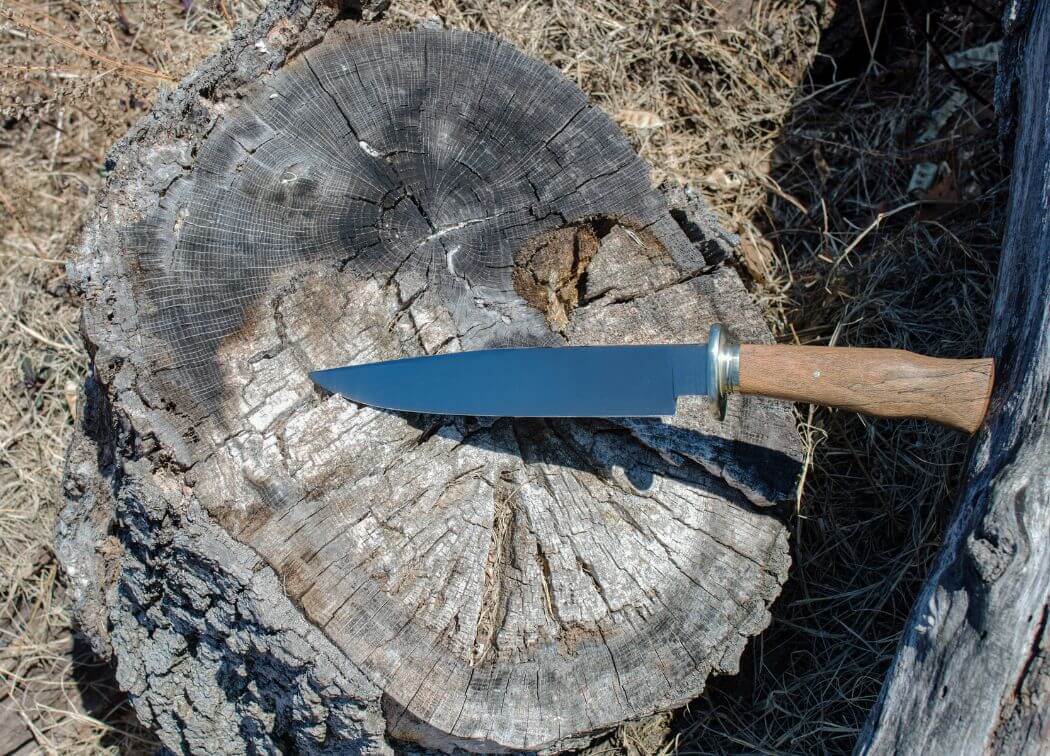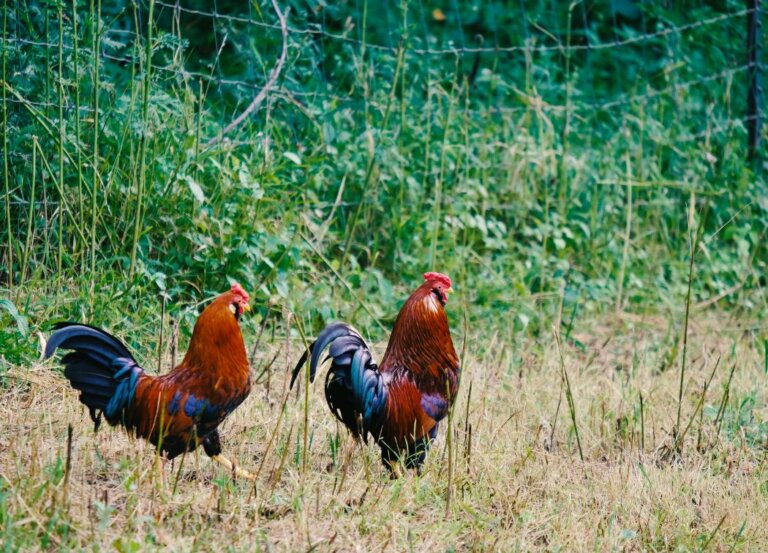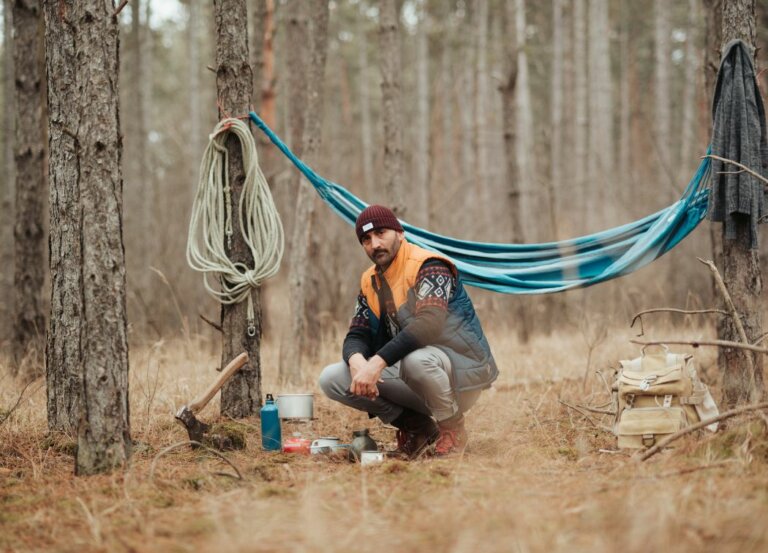What Makes a Knife a Bowie Knife
The Bowie knife was one of the first survival knives, designed to be a close combat knife plus a camping tool and wilderness survival knife combined.
Whether you are a knife aficionado or suffer from Aichmophobia (a fear of sharp objects), the Bowie knife is instantly recognizable due to its unique design.
Though originally meant for self-defense, today the Bowie knife is used by hunters for skinning and butchering game, or simply by knife collectors. It also makes a respectable wilderness survival knife and a contender for one of the better choices for a bug out bag (if you don’t mind the weight).
The first Bowie knives were made by hand by local blacksmiths for individuals. Today you can buy a Bowie knife from practically any knife manufacturing company in the world, although many enthusiasts still seek out custom knife makers for their own unique Bowie knife.

What Makes a Knife a Bowie
The Bowie knife was primarily designed to be an easily manageable, wearable, and convenient close battle knife. It was similar to a small sword with a heavy blade.
When the knife was first made, many described it as a large butcher’s knife. However, today, its clipped edge makes it instantly recognizable.
Bowie knives have a large fixed-blade fighting knife, with a clip-point at the end of the blade, and a hand guard. Its weight allows enough force to slash through foliage as well as flesh with a single swing.
History Of The Bowie Knife
The true origin story of the Bowie knife varies. However, everyone is sure the knife was designed and built either by or for one of the Bowie Brothers, Jim and Rezin.
The most popular account alleges that Jim Bowie designed the knife and commissioned Arkansas blacksmith James Black to make it. After some modifications to the model, they arrived at the final design we are familiar with today.
Black’s version of the knife includes a hand-guard, and the spine of the blade is covered with brass or silver to catch one’s opponent’s own blade during a fight.
Initially, the curved end of the blade was not sharpened. This model is now known as a Sheffield Bowie due to its popularity among cutlery factories in Sheffield, England. However, the knife was always meant for close combat and self-defense.
Jim Bowie made the knife famous for using it during the Sandbar Fight, a famous 1827 duel between Bowie and several other men that took place along the Mississippi River.
Jim was shot and stabbed, yet still managed to use the knife to disembowel one opponent, and then wound and scare off the others. The fight was reported in the local press, making the knife instantly desirable by the masses.
Other accounts claim that Rezin Bowie, after being attacked by a bull and unsuccessfully stabbing the animal with his knife, was inspired to create a tougher blade. After developing a design, the knife was made by blacksmith Jesse Clift.
There is also evidence that Rezin was the Bowie with the original design, due to his granddaughter’s letter to the Louisiana State University in 1885 claiming she witnessed Clift smith the knife for Bowie.
No matter the source, the Bowie Brothers gave the world a top quality knife design.

The Bowie Knife in Popular Culture
The Bowie knife has been featured in many literary works in the centuries since. In Bram Stoker’s Dracula, it is a Bowie knife that is used to slay Dracula instead of the usual wooden stake.
The knife has also been featured in classic works by Harriet Beecher Stowe, Mark Twain, Charles Dickens, and Jules Verne.
The Bowie knife made its Hollywood debut in the film “The Iron Mistress,” and television show “Jim Bowie,” both based on the life of James Bowie. More recently, the knife was a staple in The Alamo films, the first three Rambo movies, and the Crocodile Dundee movies.
Collecting
Originally, the knife was meant as a weapon, though it also proved useful for hunting and camping. This method of use is still prevalent today. However, today’s campers and backpackers usually rely on prepackaged and/or convenience items.
Because many variations of the knife have been developed, by size, style, and design, the Bowie knife is popular among collectors, as well. The Bowie knife is produced more than any other blade by the American Bladesmith Society.
Collecting an antique Bowie is one of the higher-end forms of knife collecting, with rare models selling as high as $200,000. Even the 19th century Sheffield Bowies can sell anywhere from $5,000 to $15,000.
What to Look for When Choosing a Bowie Knife
There are many variations on the classic Bowie knife. After identifying the intended purpose of the knife, consider the following characteristics when deciding which knife to get.
Materials
The traditional material for a Bowie knife is carbon steel because it maintained a sharp blade and is easy to sharpen. With the advancement of modern stainless steel alloys, the knives are also made with comparable materials, and even anodized aluminum.
Those interested in acquiring an authentic knife should opt for the carbon steel version. However, either material is sufficient for hunting or for display.
Blade Size
Bowie’s are known for their big fat blades, but in truth the intended purpose of the knife affects which size of blade to get. Larger knives are useful for clearing weeds and brush or chopping thin pieces of wood. The larger knife is popular among survivalists and preppers.
Small blades allow for better precision, like the kind many bushcraft skills require. They also benefit hunters and fishermen by aiding with precise tasks such as skinning or cleaning meat.
Blade Length
The Bowie knives had a standard length of 9.5 inches. The long blades are a part of the Bowie knife’s classic design and provide a striking display for collectors.
Today, manufacturers create the knives at various lengths to increase multi-functionality, though they are never shorter than 5 inches.
Tang
Tang is the shank or prong that connects the blade to the handle. Bowie knives are usually heavy and require a full tang to prevent breaking at the hilt.
For collecting and display purposes the tang is not a primary concern, but if you’re planning to actually use your blade you should look for a full tang.

Caring for Your Bowie Knife
Properly caring for your Bowie knife will give your knife a longer life. Sharpening your knife on a regular basis will prevent your blade from becoming dull. A dull blade is an unsafe blade.
Dull blades are used with more force to produce the same results, which could roll or chip the blade or cause it to slip and cut a finger or hand.
It is also important to keep the knife clean and dry to prevent rust or debris buildup, which is unsanitary. Knives are kept clean with metal rubbing paste and a clean cloth.
Final Word
The Bowie Knife is a classic knife with a long history. It serves many purposes and has become a staple in knife collecting. Its unique shape set it apart from other knives and provide functionality for many uses. Variations of the knife have created a plethora of distinctive, desirable designs.
It’s intimidating size speaks for itself as a defensive weapon, and a full tang version can be used around the campsite just as well. While the Bowie may not be for everyone in every situation, it’s universal usefulness can meet many prepper’s needs.
If you’re looking for a knife for a bug out bag or wilderness survival, consider the Bowie knife and weigh its usefulness with your unique needs.






